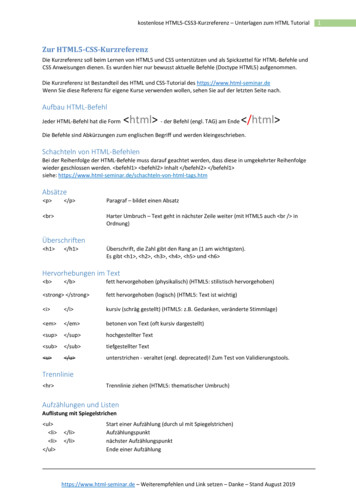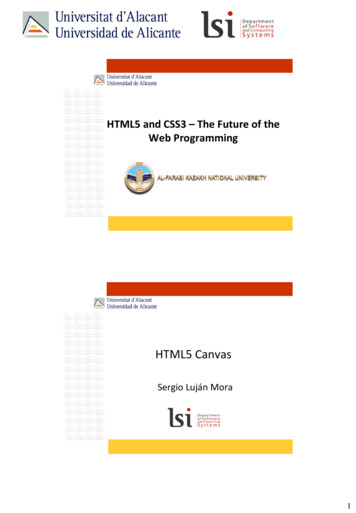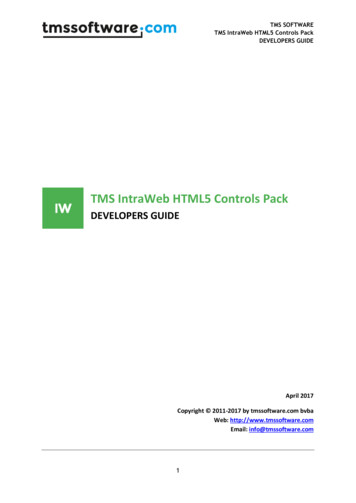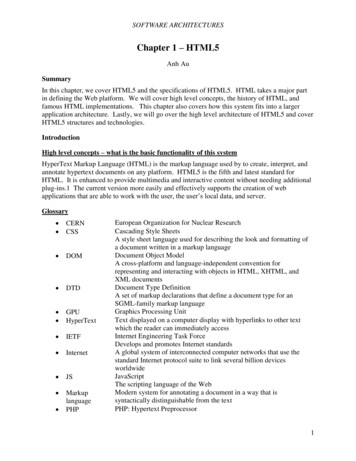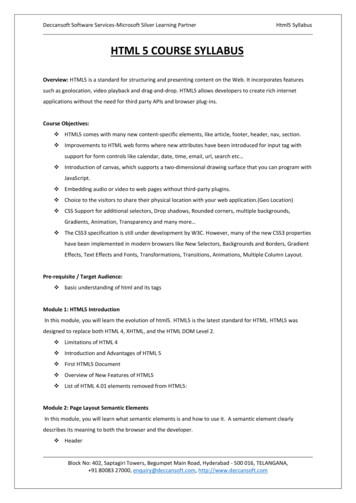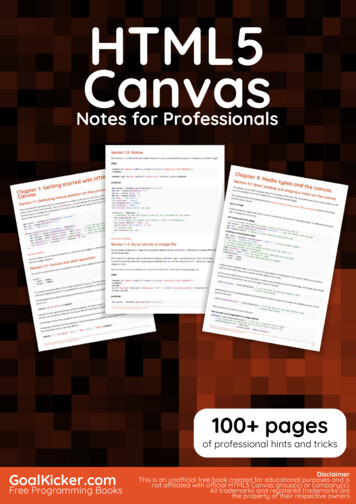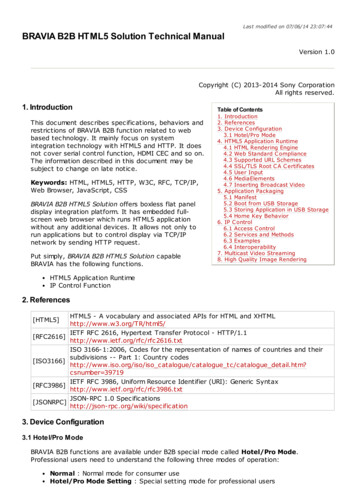
Transcription
WHITE PAPERHTML5 – the newstandard for InteractiveWebby Gokul Seenivasan, Aspire SystemsHTML5 is everywhere thesedays. Whether desktop ormobile, windows or Mac, orjust about any other modernform factor and operatingsystem, you will find anHTML5-savvy web browser.
Table of Contents1. What is HTML5. 32. RIA Future.33. Features of HTML5. 3A. Native Audio & Video Controls.3B. 2D Canvas Animation API.3C. Web Storage.4D. Web Database.4E. Web Workers.4F. Web Sockets.4G. Offline Access (AppCache).5H. GeoLocation. 5I. Drag and Drop.54. HTML5 and Mobile.55. HTML5 for Desktop.66. Future of HTML5.77. Conclusion. 8135HTML5 – the new standard for Interactive Web02
HTML5 – the new standard for Interactive WebWhat is HTML5?HTML5 is the W3C’s next major revision to HTML, which it started developing in 2004. HTML5 is not somenew language or development tool. It is just HTML with an extended layer of standardized tags and attributesfor graphic and visual effects that reduces the need for special plug-ins.Future RIA is HTML5Next generation of cloud applications is going to be RIA based, incorporating the interactivity andresponsiveness we expect from a desktop application. Future of RIA isn't going to be built around proprietarytechnologies like Flex or Silverlight but rather on the about open standards - HTML5 and JavaScript.To be more specific, it's going to be HTML5/JavaScript/CSS3. We have already witnessed strong endorsementfrom leaders like Apple, Google, Facebook, and Microsoft.It is also obvious from Adobe's recent initiative towards HTML5 related tools (Adobe Wallaby pre-release)that they understand the change coming in the Rich Internet Applications (RIA) space.As a pioneer of the RIA movement, Adobe created the right awareness and tools around it. Microsoft and Sunfollowed this path and created their own tools to grab the RIA market share (Silverlight/JavaFx)FEATURES OF HTML5A) Native Audio & Video ControlsBuilt-in media support via the audio and video elements, offering theability to easily embed media into HTML documents. Mobile browsers havethe ability to natively control multimedia display, codec and user interfaces.123B) 2D Canvas Animation API5HTML5 – the new standard for Interactive Web canvas New canvas functionality and JavaScript 2D canvas API allow twodimensional drawing, graphics and animations. With this enhancement,cross-platform games become possible for mobile browsers.03
HTML5 – the new standard for Interactive WebC) Web StorageWeb Storage provides a way for websites to store information on yourcomputer and retrieve it later.1localStorage - stores data with no time limitsessionStorage - stores data for one sessionSimilarto cookies, but it’s designed for larger quantities of information. Cookies are limited in size, and your2browser sends them back to the web server every time it requests a new page (which takes extra time andpreciousbandwidth). HTML5 Storage stays on your computer, and websites can access it with JavaScript after3the page is loadedD) Web Database5Web SQL Database API is a specification which covers storing and accessingdata through SQL. It allows Web pages to contain code that interacts withan embedded client database, which is useful for applications wanting tostore data locally or for off-line browsing. For example, phonebook contactinformation and preloading of data in preparation for 'off-line' mode are alleasily within reach.E) Web Workers5Web Workers are basically a API specification that lets you createbackground JavaScript threads to process CPU intensive tasks. Normally inbrowsers a single thread is created to handle all the JavaScript code.Sowhatever JavaScript code is run in the browser, all of them is executed inone single thread; whether you are doing some calculation or updatingpage elements.F) Web Sockets5HTML5 – the new standard for Interactive WebWeb Sockets is a technique for two-way communication over one (TCP)socket, a type of PUSH technology. Web sockets can replace longpolling.This is an interesting concept; the client sends a request to theserver – now rather than the server responding with data it may not have, itessentially keeps the connection open until the fresh, up-to-date data isready to be sent – the client next receives this, and sends another request.04
HTML5 – the new standard for Interactive WebG) Offline Access (AppCache)HTML5 introduces new methods for enabling a web site or web applicationto function without a network connection.Using the cache interface givesyour application advantages of using cache for Offline browsing, Higherspeed, Reduced server load etc1H)2 GeoLocationGeoLocation API makes the mobile device’s geographic location available toa Web app. In the past, obtaining device location was only possible usingproprietary JavaScript extensions or server-side integration via mobileoperator API.35I) Drag and DropHTML5 comes with a Drag and Drop (DnD) API that brings native DnDsupport to the browser, making it much easier to support on devices suchas mobile phones.This includes dragging of content and files from outsidethe browser, e.g. drag and drop to upload files or photos.5HTML5 and MobileMobile Web development is a hotspot for HTML5 apps. A recent McKinsey report highlighted that more than50% of all mobile apps will move to new HTML5 standards within 3-5 years. Already 46% of videos availableonline can be viewed via HTML5 instead of Flash. According to ABI research, "By 2016, more than 2.1 billionmobile devices will have HTML5 browsers, up from just 109 million in 2010".5WebKit-poweredbrowsers have the least market share on the desktop, but the highest market share onmobile devices. HTML5 is currently supported on:Ÿ iPhone, iPadŸ Google AndroidŸ BlackBerryŸ Smartphones running SymbianTable below shows the main mobile browsers available today and their current support for HTML5. Mobileplatforms on this table are Windows Phone, iPhone, Android and Blackberry respectively. Each cell indicatesfrom which version of the platform the feature is supported.HTML5 – the new standard for Interactive Web05
HTML5 – the new standard for Interactive WebSource: http://mobilehtml5.org/NoteNot all HTML5 features are listed but only the most popular and widely implemented ones.Additionally, third-party HTML5 browsers are becoming available such asŸ Opera MiniŸ Firefox MobileTable below shows the main mobile browsers available today and their current support for HTML5. Mobile1platforms on this table are Windows Phone, iPhone, Android and Blackberry respectively. Each cell indicatesfrom which version of the platform the feature is supported.2HTML5 for Desktop3As HTML5 allows for more sophisticated user experience development, it is starting to become a rival todesktop software development. HTML, JS and CSS are already installed cross-platform on the vast majorityof the world’s computers. It is not a proprietary technology and has numerous open source5implementations,free of patents.There are plenty of solutions that provide the ability to build a Web app into a self-contained installablebundle, ready for distribution. This opens up the desktop application field immensely, and helps to reduceconcerns about cross browser support.The up and coming Chrome OS will be making heavy use of HTML5. Google is adding numerous HTML5features into their online apps, such as the ability to drag and drop attachments into Gmail. Google wantsto tempt more users away from the traditional desktop to its Web-based products.HTML5 – the new standard for Interactive Web06
HTML5 – the new standard for Interactive WebSource: upport.htmlCurrent DownsidesHTML5 specification is not yet completed. It will take longer to evolve since it is a combination of standardsthat are developed by different groups. Main problem with HTML5's acceptance is that most modernbrowsers support about everything except for Internet Explorer. The new version IE9 offers excellentsupport, but as of this writing it's not quite out of beta. Video tag does not yet support real-time streaming protocol.1Also for developing mobile apps on the browser there is a lack of direct hardware integration. However, wecan expect this to change in the near future as HTML5 contains standards for accessing file systems and2Webcams. Additionally, not all the APIs are standardized in HTML5 yet (e.g. camera) and not all HTML5 isimplemented completely on all phones. As it stands, we will never be able to fully replace a native app - but3thereare a whole range of apps with requirements that do not need to be native, such as messaging andsocial network apps.Future of HTML55HTML5is rapidly advancing and will continue to evolve. While HTML5 competes directly againsttechnologies like Flash, Flex and Silverlight, it seems to be working its way into everything. Currently, it maynot be capable of creating as impressive a user experience as its competitors, but the sheer audience it willhave access to will make it a serious player.HTML5 still will not totally solve the mobile device fragmentation. However, it will act as a strong catalyst toincrease convergence of the market, as it sets a new standard with many features, and the first signsindicate that this standard is moving much faster than any previous attempts made by the W3C alone,thanks to the WHATWG.HTML5 – the new standard for Interactive Web07
HTML5 – the new standard for Interactive WebTo get the most out of your mobile site, achieve the widest reach and get the best experience oneach mobile device you would still need specialized solutions that can adjust media renderingbased on the device and/or browser recognition and are able to adapt the level of HTML5 featuresbased on the current available browser support.ConclusionHTML5 is a formidable technology and has the potential to make the web even more ubiquitous andpervasive as it is today from desktop computers to mobile devices and in the future maybe even domesticsappliances.Mobile web provides the best hope for building a cross-device mobile ecosystem & HTML5 is definitely acritical piece to achieve this.Other ReferencesDive into HTML5http://diveintohtml5.info/HTML 5 Tag Referencehttp://www.w3schools.com/html5/html5 reference.aspHTML: The Markup Language Referencehttp://dev.w3.org/html5/markup/Building Web Pages with HTML5http://www.webmonkey.com/2010/02/building web pages with html 5/ABOUT ASPIRE SYSTEMSAspire Systems is an Outsourced Product Development firm committed to helping our customers buildsoftware products better and faster. We work with some of the world’s most innovative Independent1SoftwareVendors and software-enabled businesses, ranging from start-ups to established industry leaders,transforming the way software is built.2Aspire provides complete product lifecycle services, ranging from new product development and product3advancementto product migration, re-engineering, sustenance and support. Our product developmentteams are spread between our Global Innovation Center in Chennai, India and offices in the United States.5Aspire Systems India Private LimitedPlot No 1/D-1, SIPCOT IT PARK, Siruseri, Tamil Nadu - 603 103Tel : 91-44-67404000. Fax: 91-44-67404234E-mail : info@aspiresys.comWeb: www.aspiresys.comHTML5 – the new standard for Interactive Web08
The up and coming Chrome OS will be making heavy use of HTML5. Google is adding numerous HTML5 features into their online apps, such as the ability to drag and drop attachments into Gmail. Google wants to tempt more users away from the traditional desktop to its Web-based products. HTML5 for Desktop HTML5 - the new standard for Interactive Web



